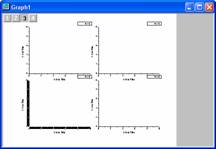1.26 FAQ-140 What is a graph layer and how many layers can I have in a graph page?Graph-Layer-Defination
Last Update: 1/8/2019
A typical graph is comprised of the following: A set of X and Y (and optionally, Z) coordinate axes, one or more data plots, associated axis titles, text labels and drawing objects.
These elements make a movable, sizeable unit called a layer. A single Origin graph page must contain at least one, and may contain as many as 1024, graph layers(a graph with zero layers is not defined since if you delete all layers from the graph page, the graph window is deleted).
Because the layer is a self-contained unit, it can be moved about and arranged on the graph page in practically unlimited ways. Layers in a multi-layered graph may be partially superimposed (as in an "inset" graph), completely superimposed (as in a "double-Y axis" graph), or they may be entirely separated (as in a "panel" graph).
While a graph may have multiple layers, only one layer is active at any given time. The active layer is denoted by a depressed layer n icon in the upper left corner of the graph window. In the following graph, layer 3 is the active layer as indicated by both the depressed layer 3 icon and the View: Show: Active Layer Indicator.

When you click on different areas of your graph, the active layer will change depending upon what layer you click in. If you do not want this behavior, you can configure Origin so that a graph layer can be made active only by clicking on the layer icon. To do so, select Format: Page. This menu command opens the Plot Details dialog box with the page (graph) icon selected on the left side of the dialog box. Select the Layers tab, and then check the Set Active Layer by Layer Icon Only check box. (Note: The setting works only for current graph.)
Keywords:axes, plots, multi, multiple, axis
|